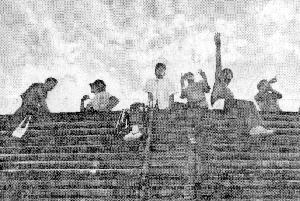|
|
NATION/WORLD
Des Moines Sunday Register
December 14, 1997, Page AA
Welcome to the heartland --
of drug traffic
- States like Iowa, Wyoming and Kansas are at the
crossroads of the nation's top smuggling corridors.
By RICHARD A. SERRANO
LOS ANGELES TIMES
Cheyenne, Wyo. -- Here in the land
of wide-open spaces and clean living, as well as in other communities across the
midsection of America, Mexican drug cartels are opening new and lucrative markets for
contraband brought from beyond the Rio Grande.
Eager to create ambitious distribution points, the cartels are
successfully targeting traditional God-fearing communities like Cheyenne and Casper in
Wyoming -- and other cities in such states as Kansas, Nebraska and Iowa. They are
bringing with them the drugs that long have plagued larger urban centers across the
country.
Some years back, gangs brought drive-by shootings and drug dealing to
the American heartland. But "our greatest problem today is illegal aliens and
drugs," said Tom Pagel, director of the state Department of Criminal Investigation in
Cheyenne. "The vast majority of this is being transported up from Mexico, and
we're getting our butts kicked over it."
Smuggling vast quantities of methamphetamine and hustling their
standard cocaine shipments, the Mexican drug criminals are aggressively trying to
outmarket the Colombia cartels they have replaced.

Sen. Charles Grassley of Iowa, a key drug-pipeline state, calls it "absolutely
critical" that Mexico clean up its side of the border.
|
International Impact
Taking over the drug routes once run by
Columbians, the Mexicans' influence and the level of public corruption in Mexico have
become major sources of friction between that country and the United States.
In October, the U.S. government reported that more than 40 percent of
the illegal immigrants who were deported to Mexico last year had first been convicted of
drug charges in U.S. courts. Those numbers fit an overall pattern of an increase in
crimes committed by illegal immigrants.
Never Seen Before
The offenses are often occurring in cities and towns where, in the
past, the worst crime was likely to be transporting stolen cattle. The situation has
fueled a sharp increase in teen-age narcotics use, and the courts and drug treatment
centers are seeing more kids more strung out than ever before.
Kathleen Sloan, a drug treatment specialist here, is surprised at the
number of kids -- and how young they are, some just 14 -- who pass through her doors these
days.
"It began about two years ago," she said. "What
was really noticeable was that it wasn't experimental drug use any more. In the last
eight months it's gotten to where it seems out of control."
The upsurge in drugs also has prompted a keen awareness in places like
Cheyenne that law enforcement must act decisively to reverse the trend. Already,
police here are taking Spanish-language training, and federal prosecutors have recently
put away a Mexican national working as a major drug "primo" in Wyoming.
In Washington, officials have been saying for some months that Middle
America is no longer an outpost garrisoned off from the drug menace. They warn that
as long as there is a demand, even in places as small and distant as Cheyenne, there
someday will come a supplier.
White House Drug Policy Director Barry McCaffrey said recently,
"Colorado, Utah, and Wyoming, the Rocky Mountain heartland of America, are
increasingly becoming populated with Mexican drug trafficking organizations and violent
gangs using this major transportation crossroads as a trans-shipment center."
Federal drug enforcement officials say that Interstate 25 is a historic
smuggling route north out of El Paso, Texas, and that the nation's main east-west
corridors, Interstate 70 and Interstate 80 -- which runs through Iowa -- are increasingly
becoming drug pipelines.
Cheyenne is located at the cloverleaf of Interstates 25 and 80.
The drugs move north and east; the money flows west and south.
Sen. Charles Grassley, R-Ia., head of the Senate Caucus on
International Narcotics Control, said it was "absolutely critical" to pressure
Mexico to clean up its side of the border.
In Des Moines, Polk County District Associate Judge Carol Egly has
noticed in the past four years an increase in the number of drug users. "We're
getting many that are totally whacked out and crazy," she said.
She also has seen a growing number of Mexican nationals appearing on
drug-pushing charges in her courtroom, unable to speak English or understand the charges
against them. And yet, she said, they realize that even if they go to prison and
then are deported to Mexico, it will not keep them from returning.
"Why Des Moines? Why Iowa?" Egly asks herself. "I still
don't know the answer."
Meth's Long Reach
Here in Wyoming, one of the least populated states in the country,
police chalked up 18 arrests on drug, illegal-immigrant and firearms charges in just one
12-day span in October. Thirteen of the suspects were Mexican nationals.
At the same time, drug use had climbed steeply, primarily for
methaphetamine, the most common narcotic from Mexico that teen-agers and young adults
across the Plains are smoking or shooting into their arms. The drug is particularly
popular because it gives a fast and lasting high, and sharply curbs one's appetite.
In 1993, "meth" accounted for on 18 percent of Wyoming's
drug-related arrests. So far this year, the figure is 46 percent.
Not Safe Anymore
Iowa Judge Egly's sentiments -- why us? why here? -- are being echoed
all across Middle America, the part of America that, for a time, thought is was safe.
Said Stephen Miller, deputy director of Wyoming's Division of Criminal
Investigation: "This is hitting us all in the face all at once. Good Lord, what is
happening here in Wyoming?"
Can it all be stopped?
And in only 5 years?
LOS ANGELES TIMES
Miami, Fla. -- President Clinton has
directed his administration to develop an ambitious strategy to stop the flow of drugs
across the nation's border with Mexico within five years, the president's drug czar said.
Gen. Barry R. McCaffrey, director of the office of national drug
control policy, said the goal is "achievable," even though an estimated 70
percent of all illegal narcotics sold in the United States currently come into the country
via Mexico.
"We're going to try to stop drug smuggling into the United States
across the Mexican-U.S. border in the next five years -- substantially stop it,"
McCaffrey said.
Some politicians and law enforcement officials immediately questioned
the feasibility of sealing the border from drugs. They noted that not only does
demand for drugs remain high in the United States, but the North American Free Trade
Agreement has increased cross-border activity.
McCaffrey disclosed the administration's plans after an event at which
Clinton praised the U.S. Coast Guard for a "banner year" in fighting the drug
war. The president noted that the Coast Guard has tripled its seizures of cocaine.
The drug czar said he spoke with Clinton about the "Southwest
Border Initiative" after the Coast Guard event, a discussion that followed a two-hour
meeting he had with White House chief of staff Erskine Bowles on Wednesday.
McCaffrey added that he expects the president to outline the initiative's final shape in
his State of the Union address early next year.
But Rahm Emanuel, assistant to the president, said no decision has been
made about including it in the State of the Union speech. "The goal is to get
something developed," Emanuel said. "We have returned the rule of law to
the border, but we have more work to do."
 |
| Border Patrol Agent Dave
Kennedy checks a border fence at San Ysidro, Calif. Despite the efforts of
Kennedy and his colleagues, illegal immigrants -- like the ones waving to friends, at
right -- continue to pour across the border, often on drug runs. |

|
The Des Moines Register
Sunday, December 14, 1997, Page AA
letters@news.dmreg.com
|

